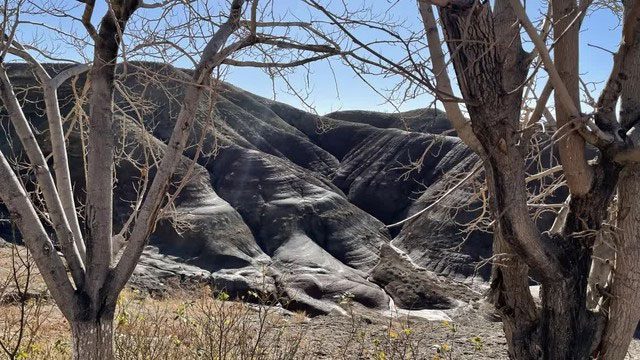According to CNN, Nakhchivan is a region located about 260 miles west of Baku, the capital of Azerbaijan. This destination boasts a long list of historical attractions, including towers, castles, tombs, and even dream caves.
The highlight of Nakhchivan is the Duzdag Salt Mine, also known as the “Salt Mountain,” which serves as the largest medical tourism destination in the region.
Hidden 360 feet (110 m) underground, this destination offers complementary treatment methods related to respiratory diseases. The salt mountain consists of rooms that were first hollowed out nearly 5,000 years ago.

The Duzdag Physiotherapy Center was established in 1979. (Photo: CNN).
Inside the Old Salt Mines
Just a 7-mile drive from Nakhchivan city, the caves are spectacularly located in the mountains at an elevation of 3,848 feet (1,173 m).
The modern Physiotherapy Center in Nakhchivan was founded in 1979, based on a salt mine excavated by archaeologists in the 1970s. It is believed that salt has been mined here since the 3rd millennium BC and was exported to the Middle East.
It is still unclear exactly how the caves became renowned for their healing properties through salt therapy. There are various stories regarding their origins, offering contradictory explanations.
Legend has it that the caves have long been revered by the local people for their restorative abilities, with everyone viewing Duzdag salt as sacred. During excavations in the 20th century, renowned archaeologists discovered healing properties for bronchitis and asthma when visiting the site.
Salt Therapy

These paintings inside the Duzdag salt cave. (Photo: CNN).
Salt therapy is not a newly discovered treatment method. In the mid-19th century, Polish physician Feliks Boczkowski, who worked in a salt mine, observed that the miners rarely suffered from respiratory diseases and appeared to have significantly healthy physiques.
Dr. Boczkowski is credited with discovering this method, later named halotherapy, which means breathing air infused with tiny salt particles to improve respiratory function.
Halotherapy has gained popularity in recent years. Experts note that salt in the air can help thin mucus in the airways and draw out moisture. The saline environment is also typically free of allergens.
However, the American Lung Association advises consulting a doctor before undergoing halotherapy or salt therapy.
When salt therapy is conducted beneath the Earth’s surface, it is influenced by the climate conditions and salty air present in the natural caves. This is referred to as saline therapy. Such salt caves exist in various places worldwide, including Ukraine, Hungary, Poland, Turkey, Germany, and Switzerland, and are widely used by asthma patients as an alternative treatment method.
Notably, what sets Duzdag Salt Mountain apart is its horizontal position, allowing patients to acclimate to the cave conditions as they walk from the entrance to the care rooms, approximately 900 feet (or 300 meters) away.
The winding path into the mine first leads to a cozy single-story wooden building at the Physiotherapy Center. Surrounding the cave are the mystically sparkling walls within the tunnels.
Even before entering the cave, the distinctive scent of Duzdag salt is immediately noticeable, starkly contrasting with the light salty breeze from the nearby Caspian Sea.
The glittering salt layers of the 8.2-meter (nearly 27 feet) thick walls. The spacious tunnel features benches on both sides and even a rest area with a TV and tables, creating a comfortable atmosphere.

The salt walls are nearly 27 feet thick. (Photo: CNN).
Upon closer examination of the small pink rocks near the walls, it is found that even these rocks are made of salt. People collect larger pieces and keep them at home, believing that the crystals will ward off negativity.
It takes time to get used to the strong salty smell, but breathing in the tunnel is not difficult. The center states that the natural ventilation system in the cave prevents the accumulation of harmful gases such as carbon dioxide, methane, and nitrogen.
The favorable combination of elevation, temperature, humidity, atmospheric pressure, the ion composition of oxygen in the mine, and bacterial composition successfully treats conditions such as bronchial asthma, chronic bronchitis, hay fever, and allergic rhinitis when present.
Microclimate
The microclimate inside the cave is quite stable year-round. Humidity levels range from 20-25%, and although the outside temperature is around 3 degrees Celsius (37°F), the temperature inside the cave remains a comfortable 18-20 degrees Celsius (64-68°F).
The center has expanded its treatment rooms to accommodate approximately 474 patients, and the Duzdag Hotel was additionally constructed in 2008. Located just over a mile from the caves, this is part of the Duzdag Physiotherapy Complex, where patients come for examinations and spend a few days becoming accustomed to the climate.
During a stroll through the caves in December, only one other group of tourists visited. On average, 3,500-4,000 patients visit the caves each year, mostly in the summer, as most people plan treatments during school break months and can take time off work.
In recent years, this quiet health retreat has developed a specialized post-Covid-19 rehabilitation program to address the virus’s impact on respiratory diseases. The salt cave is also noted for its immune-boosting effects, improving circulation and skin conditions, while reducing stress.
While the actual benefits of the salt cave remain unproven independently, the unusual airflow within the cave undoubtedly supports therapeutic treatments related to respiratory diseases.
“Sitting on the bench, surrounded by the tranquility of the sparkling walls, one thing is certain: the cave quietly soothes tensions and allows for an easy immersion into the serene atmosphere, leaving behind the anxieties of daily life,” the author writes.
- The century-old stone path through the forests in the North: A historical mark, visitors describe it as like a fairy tale
- The 30-hour train journey that sells out extremely quickly, the stopover likened to a winter wonderland
- The land known as the “dragon vein” unique to China: A convergence of emperors, nearly 4,000m high, containing rare treasures


















































